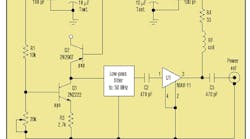Wide-Band Analog White-Noise Generator
Commercially available white-noise generators are rather expensive. The circuit presented here, however, is an inexpensive version that produces frequencies up to about 300 MHz. Its operation is based on the noise generated by the Zener breakdown phenomenon in the BJT inversely polarized base-collector junction. In other words, such shot noise involves the statistical fluctuations of the current flow present in the bipolar transistor.
The generator shown makes use of a common 2N2907 biased by the constant current source supplied by a 2N2222 (Fig. 1). To increase the amount of shot noise attainable, the collector of the 2N2907 is left open and the base-emitter is reverse-biased. That is, the BJT is connected as a Zener diode to exploit the reverse breakdown phenomenon.
With this configuration, the reverse breakdown voltage exhibited by the emitter-base junction can be easily observed using an ordinary spectrum analyzer. The attainable bandwidth is about 300 MHz, and the power output is about -70 dBm.
To increase the noise power, one or more amplifiers, such as the monolithic MAV-11 from Mini-Circuits, can be added. The 50-MHz low-pass filter (the PLP-50 from Mini-Circuits) inserted between the generator and the first MAV-11 is necessary to maintain the amplifier output power compression at an acceptable value. But, of course, with this configuration, the bandwidth is restricted to the 0-50 MHz range, i.e., the power spectrum vanishes outside the cutoff frequency of the filter.
In Figure 1, R4 is needed to limit the current delivered to the amplifier. L1 provides high impedance to isolate the dc source from the RF signal. C3 removes any dc content from the output of the generator. The 20k trimmer connected between the base and ground in Figure 1 permits a wide range of the attainable output noise up to -60 dBm (Fig. 2).
At the Istituto di Radioastronomia del C.N.R., this circuit is currently being used to simulate cosmic white noise, in which the radioastronomical signal (a coherent white noise) to be extracted is buried.


